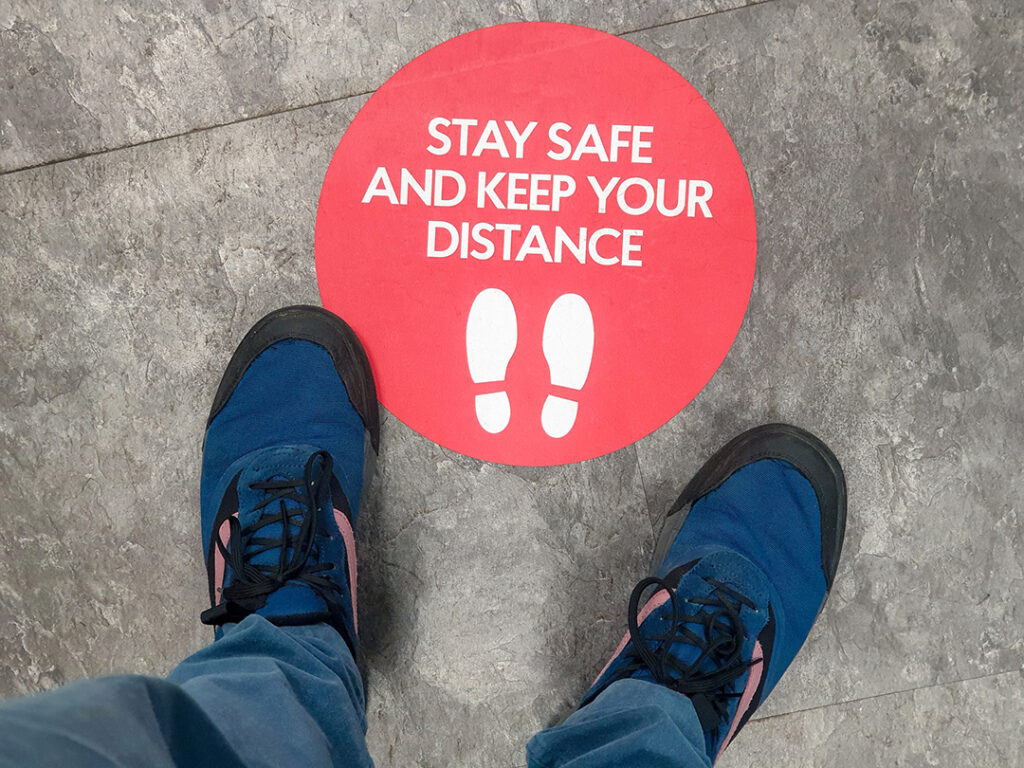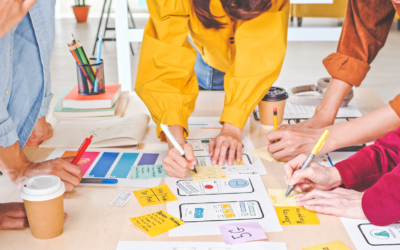Table of Content
- Introduction
- Signage: Essential in Public Spaces
- Infographics Design: Data Matters
- Interior Design: User Experience Design…the New Reality in Public Spaces
- User Interface and User Experience: Continuing Digital Interactions
- Social Media Growth: Information, Business, and More
- Opportunities and Responsibility
Introduction
Inevitably, the COVID-19 pandemic has changed the rules of the game in our daily lives: we all have new ways of working, exercising, taking care of our health, socializing, and shopping, to name just a few. These changes have presented a lot of new opportunities—and additional responsibility—for designers and design-related professionals. We are now in charge of taking the products we work with to a higher level, focusing even more on interaction, user behaviors, and safety.
This post offers some thoughts and ideas—from different perspectives and disciplines—about how design can help us adapt to the new reality of COVID-19. Enjoy!
Signage: Essential in Public Spaces
Signage refers to the need to communicate in a limited space through simplified graphics, text, or specific information. Signage is used to identify, regulate, inform, and guide users within a specific context and situation.
Due to COVID-19, signage design has now become more significant and essential than ever. The pandemic led to the introduction of social distancing in public spaces—and, as a result, created the need to communicate user-specific rules and restrictions—health recommendations and alert signs, for example—that users must consider before engaging in certain activities.
Because of these new practices, we now find floor signage indicating where we need to wait in a line or signboards indicating what types of symptoms we should be concerned about. Also, as many stores hadn’t previously contemplated how to adapt spaces for long waiting lines with socially-distanced spaces, the logistics for guiding customers into specific places has changed frequently in some instances.
These situations highlight how important signage is in our current circumstances. As designers, we must consider how crucial it is to engage and plan this type of signage as clearly and directly as possible. Our goal is to communicate to the user quickly and effectively about how to proceed and what rules to follow.
Infographics Design: Data Matters
An infographic is an illustrated editorial product used to explain detailed information and data about a specific topic. The function of an infographic is to present the user with the largest amount of information in the most explanatory and straightforward way possible. Infographics are composed of both text and illustrations, and, sometimes, maps and graphs. In short, the primary purpose of the infographic is to educate.
One of the most critically significant lessons learned from COVID-19 has been that information is important and data matters. We all receive vast amounts of data through many platforms every day regarding the virus, including number of cases, hospitalizations, recoveries, and, sadly, deaths.
Much of this information needs analysis and dissection to better understand how the disease is spreading as well as the demographic conditions, symptoms, severity, etc. Infographics are a great tool for exemplifying and explaining this type of information. Infographics also give designers the opportunity to help fight misinformation as well as prevent the wrong interpretation of data.
The role of designers in organizing and presenting data is critical during this time. It’s our job to help users understand the information presented in a quick and efficient manner. This effort involves various design disciplines, such as editorial design, illustration, graphing, and others.
Interior Design: User Experience Design…the New Reality in Public Spaces
In developing user experiences, interior designers and graphic designers have worked together for many years to create and establish guidelines for customer behavior while interacting with specific spaces and in specific contexts.
For instance, how we move inside a store or how we interact in a bank, coffee shop, or restaurant are examples of users moving and performing actions in, let’s say, an intuitive way.
Designers have long known the established patterns for the experience of shopping in a store or ordering food in a restaurant. But what happens when we add social distancing requirements, restrictions limiting the number of customers per space, and new sanitizing guidelines—all of which call for the reordering of familiar areas? Traditional interactions that users understood, embraced, and felt accustomed to are now being affected by the new reality of COVID-19.
Interior and graphic designers now have the task of studying and determining the best way to continue providing the user with a satisfactory experience while interacting in familiar establishments and public spaces while also considering safety guidelines, regulations, and restrictions that have been put in place to reduce and/or prevent the spread of COVID-19.
Businesses need creative solutions for the new challenges of providing customers with a safe environment in which to interact with their products or services. For example, we have seen some companies begin to provide specific areas for users to stay while waiting for a service.
User Interface and User Experience: Continuing Digital Interactions
Applied primarily to digital interfaces, UI/UX is finding a growing market with the arrival of COVID-19. From both a product perspective and sales perspective, we have seen an increased need for digital interactions as the lack of physical interactions has affected everyone, from big corporations to small businesses.
Big corporations are now studying ways to adapt and create solutions to satisfy or continue satisfying customers’ needs.
For example, for customers used to going to the gym daily, now there are in-home solutions like cycling bikes with integrated monitors for classes as well as websites and platforms that serve as digital classrooms where exercise routines are offered.
The health sector is also seeking new technology resources in order to monitor patients’ bodies and track health data without patients having to physically go to a doctor’s office. Thermometers, scales, oximeters, blood pressure monitors, and other products can sync with mobile devices and provide users’ statistics and information regarding their health. The process of designing and developing the products’ actual interface and interaction with mobile devices that provide data analysis is where UI/UX comes into play.
For small businesses, having a digital presence is now an essential part of surviving the economic complications that have resulted from the lockdowns put in place to prevent the spread of the disease. We have seen numerous businesses and establishments adapting to our new reality by providing remote services and offering products directly. In fact, there is a growing need for companies to have a space on the web for selling their products, since physically going to the store is no longer possible for some customers. In these cases, UI/UX design can help in setting functional and useful sites where customers can fulfill their needs and businesses can continue providing their products.
Another way UI/UX design has contributed to COVID-19 informational efforts has been by creating Mobile Applications. Some of these Apps use geolocation technology for the purpose of contact tracing. Countries such as Japan, New Zealand, United Kingdom, Australia, Canada, and France, among others, have implemented contact tracing Mobile Applications.
Other specialized Apps have been developed for purposes such as educating users with a list of symptoms, informing users of hospital availability, communicating protocol to attend revisions, and offering meaningful information to guide users possibly infected with COVID-19 to get medical attention.
Social Media Growth: Information, Business, and More
Social media platforms have become a crucial factor in the COVID-19 pandemic. From sharing information (and spreading misinformation) to connecting brands with customers, increasing digital interactions among users, and increasing mental health issues due to information overload and social isolation, social media has inevitably become a significant part of our lives.
Fortunately, design can help manage social media concerns by contributing to the distribution of informative data and working to prevent opportunities for the spread of misinformation. Design can help create meaningful and significative content as well. Across all social media, we have seen the growth of initiatives that encourage mental health care practices such as meditation and mindfulness as well as those promoting appreciation campaigns for healthcare workers.
Design contributes to small, medium, and large businesses alike, helping them continue to interact with their customers through new avenues of digital marketing and communication.
Opportunities and Responsibility
Every challenge represents opportunity, and COVID-19 has brought us many challenges that have required developing new ways of interacting with the world.
Across disciplines such as architecture, marketing, communication, and many others, design contributes to satisfying users’ needs and establishing patterns with organizational and informational purposes through spaces and graphics (printed or digital).
The value of design is certainly in the spotlight now because of COVID-19. More than ever before, our goal—and our responsibility—must be to deliver reliable and functional solutions to address our current and ongoing global issues.












